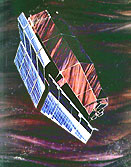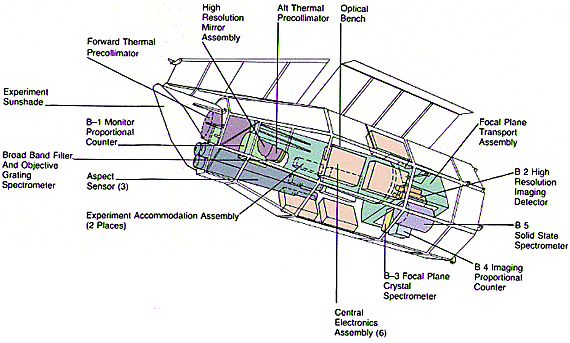|
|
Einstein (HEAO-2)

HEAO-2, Einstein, was a NASA mission which involved a consortium of scientists
from several institutions, including the Harvard-Smithsonian Center for
Astrophysics, Columbia University, NASA/Goddard Space Flight Center, and MIT.
Einstein was launched into low Earth orbit by an Atlas-Centaur rocket on
November 13, 1978 and operated without significant interruption until April
1981. It was the first X-ray mission to use focusing optics with imaging
detectors with an angular resolution of a few arcseconds, a field-of-view of
tens of arcminutes. The sensitivity was several 100 times greater than any
previous X-ray astronomy mission.

The payload consisted of a high resolution X-ray telescope and a focal plane
assembly capable of positioning the focus at one of four instruments: the High
Resolution Imaging detector(HRI); the broader field Imaging Proportional
Counter (IPC); the Solid State Spectrometer (SSS); and the Focal Plane Crystal
Spectrometer (FPCS). Einstein also contained a Monitor Proportional Counter
(MPC) co-aligned with the telescope. The MPC monitored the 1-20 keV X-ray
flux of the source(s) being observed simultaneously by the operational
focal plane instrument. Einstein was a pointing mission with an active
attitude control system capable of arcminute pointing and arc second attitude
determination.
Einstein was the first X-ray observatory to open the utilization of its
facility to a larger astronomical community via a Guest Observer Program.
During its mission lifetime, the Einstein Observatory carried out over 5000
targeted observations including AGNs, X-ray binaries, CVs, SNRs, stars, and
clusters of galaxies. These observations, and their scientific outcome, lifted
X-ray astronomy into the mainstream of astronomical research.
The IPC was a position sensitive proportional counter which provided good
efficiency and full focal plane coverage, with moderate spatial and spectral
resolution. There were 2 such assemblies on Einstein, identical except for the
entrance window material. The IPC had a FOV of 75´ x 75´, with a
spatial resolution of ~1´. The effective detector area was ~100 cm2
, and the time resolution was 63 msec. The energy range was 0.4-4.0 keV,
and the background count rate was ~10-2 cts/sec.
The HRI was a digital X-ray camera which provided high spatial and temporal
resolution over the central 25 arcmin of the Einstein focal plane. The
instrument had no inherent spectral resolution, but spectral studies could be
performed using interchangeable broad band filters and Objective Grating
Spectrometers (OGS). When operated with the OGS, the HRI had an energy
resolution of 10-50. There were 3 HRI detectors onboard, identical except for
the UV opaque shade material. The HRI had a 25´ diameter FOV, with a
spatial resolution of 2" within 5´ of the axis. The effective area
was 20 cm2 at 0.25 keV; 10 cm2 at 1 keV; and 5
cm2 at 2 keV. The time resolution was 8 msec. The energy range was
0.15-3.0 keV. The background was ~5 x 10-3 cts/arcmin2/
sec.
The SSS consisted of a cryogenically cooled lithium-drifted Si(Li) detector
at the focus of an X-ray imaging telescope. It subtended a six arcminute
diameter circular aperture, and was slightly defocused so that a point source
was blurred to a radius of ~1 arcmin. The spectral resolution was
noise-limited, with a 160 eV FWHM, and was nearly energy independent over the
detector range 0.5-4.5 keV. There was 128 energy channel resolution, with each
channel being about 45 eV wide. A time-dependent build-up of ice (water) on the
detector surface occurred because of cryopumping of ambient outgassing material
onto the 100 K detector. It was periodically defrosted by heating to 220 K at
the beginning of a series of three days of observations. Each defrost reduced
the total amount of ice that returned, such that after 9 months the ice
covering was almost gone. A model had been developed that predicted the ice
parameter as a function of time, and was used to obtain the correct response
matrix for any given observation. The cryogen keeping the SSS at its
operational temperature of 100 K ran out, as expected, in October 1979,
between Day 276 (Oct 3) and Day 286 (Oct 13).
The Focal Plane Crystal Spectrometer (FPCS) was a Bragg crystal spectrometer
with 6 different crystal diffractors and two redundant position-sensitive
detectors which were multiwire proportional counters. The FPCS had a set of 4
apertures to select from, with dimensions of 1´ x 20´, 2´ x 20´,
3´ x 30´, and 6´ diameter, respectively. Only the latter three
were actually used in observastions. The effective area of the FPCS was of
order 0.1-1.0 cm2, and its energy resolution was 50-1000. In a
typical FPCS observation, a small segment (20-80 eV) of spectrum would be
obtained centered on a specific spectral feature by stepping the orientation of
the selected crystal: features in the energy range from 0.42-2.6 keV were
observed.
The MPC was a non-focal plane instrument that monitored the 1-20 keV X-ray
flux of the source(s) being observed simultaneously by the operational focal
plane instrument. The MPC was a collimated proportional counter filled with
argon and carbon dioxide. It had a circular field of view, 1.5° in
diameter (FWHM), which was co-aligned with the telescope. A 1.5 mil Be window
sealed the gas in the detector and shielded the detector from ultraviolet
radiation. The active area of the MPC was 667 cm2. Each photon
detected by the MPC was pulse-height analyzed into one of 8 bins, the size of
which increased logarithmically with energy from 0.41 keV, for the lowest
energy bin, to 6.72 keV for the highest energy bin. The MPC had an energy
resolution of ~20% at 6 keV. The MPC obtained useful data from 1978 November 19
until 1981 April 17, with the exception of a 3-month period from 27 Aug 1980
to 8 Dec 1980 when operation was intermittent, due to Einstein Observatory
attitude control problems.
[HEAO-2 Home]
[About HEAO-2]
[Archive]
[Software]
[Gallery]
[Publications]
Page authors: Lorella Angelini Jesse Allen
HEASARC Home |
Observatories |
Archive |
Calibration |
Software |
Tools |
Students/Teachers/Public
Last modified: Monday, 20-Apr-2020 17:38:07 EDT
|



